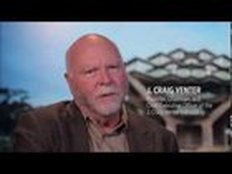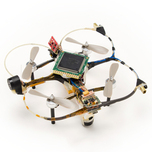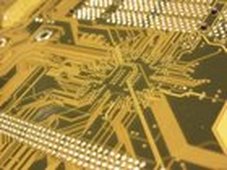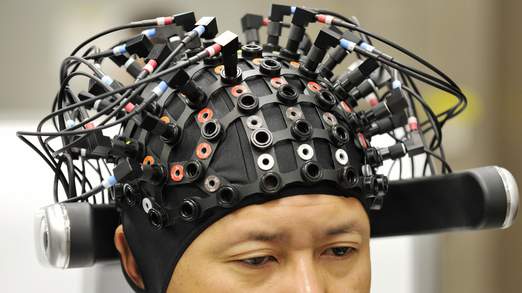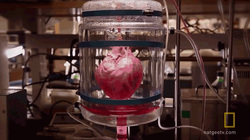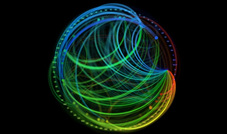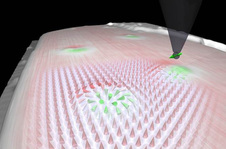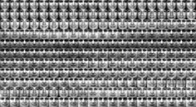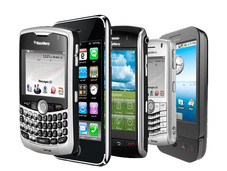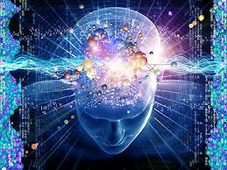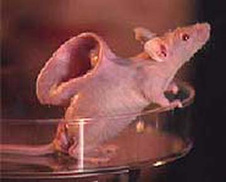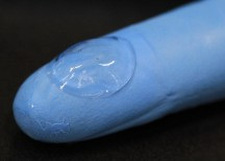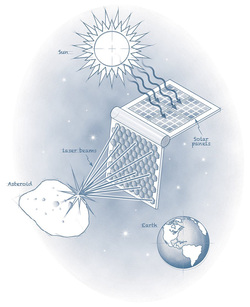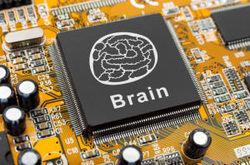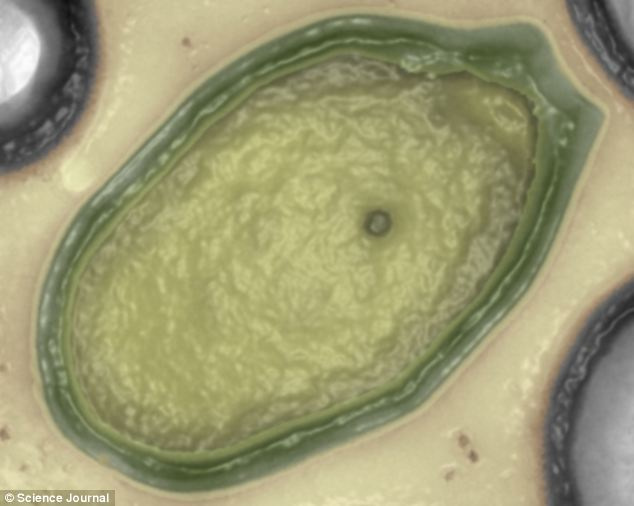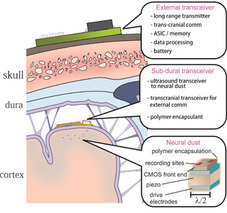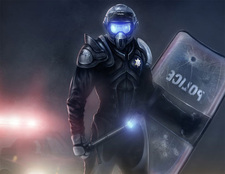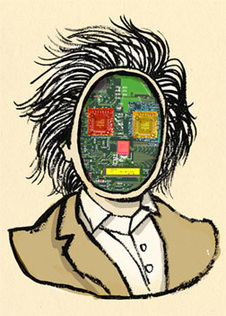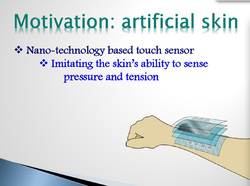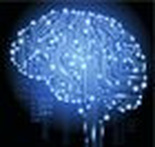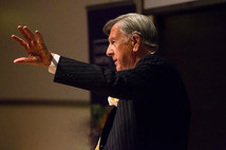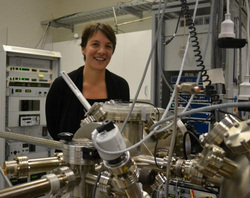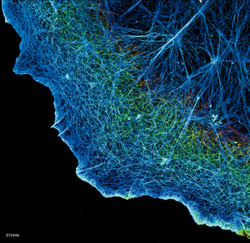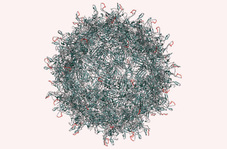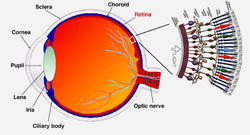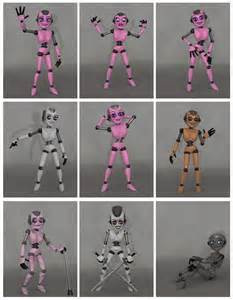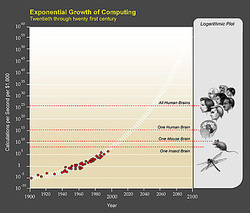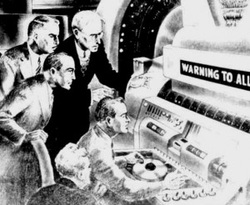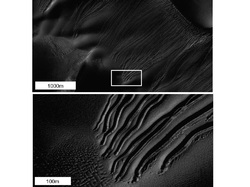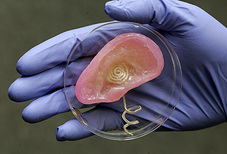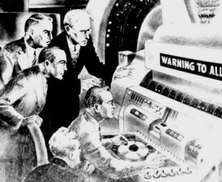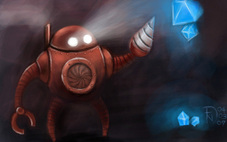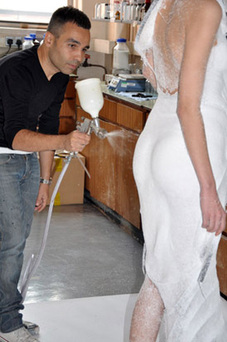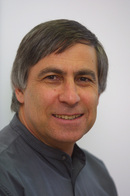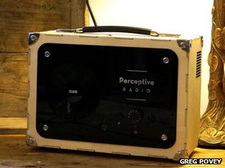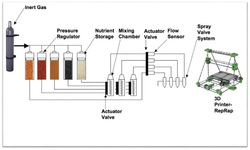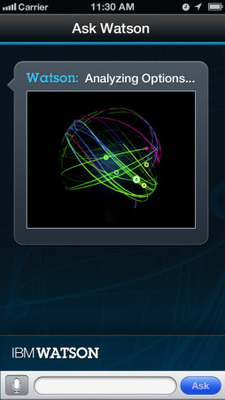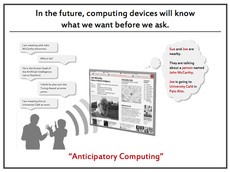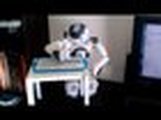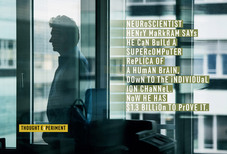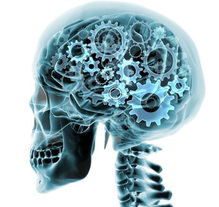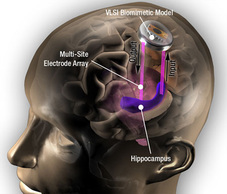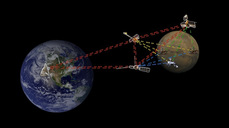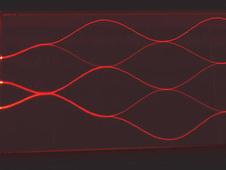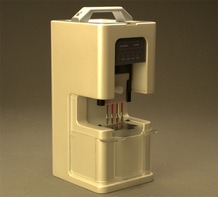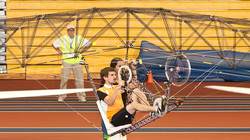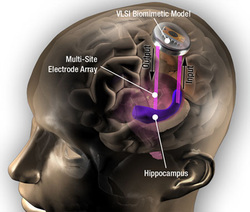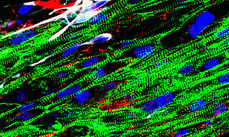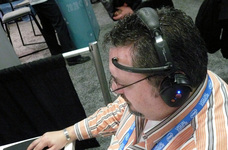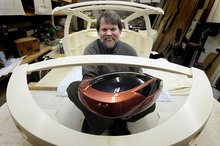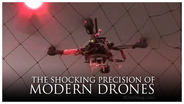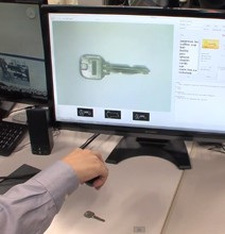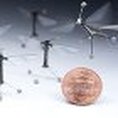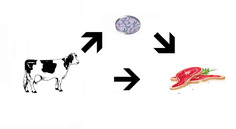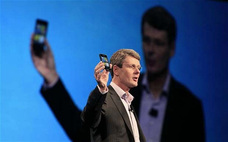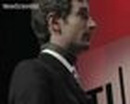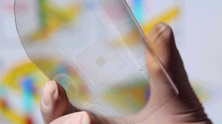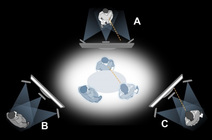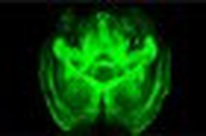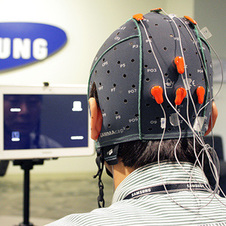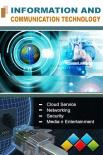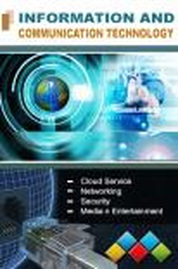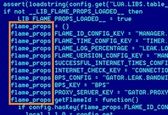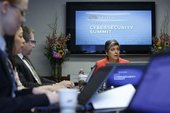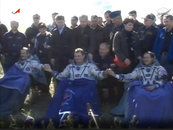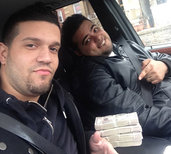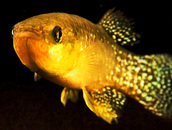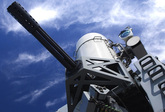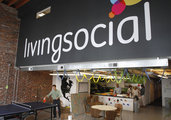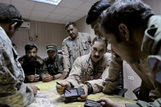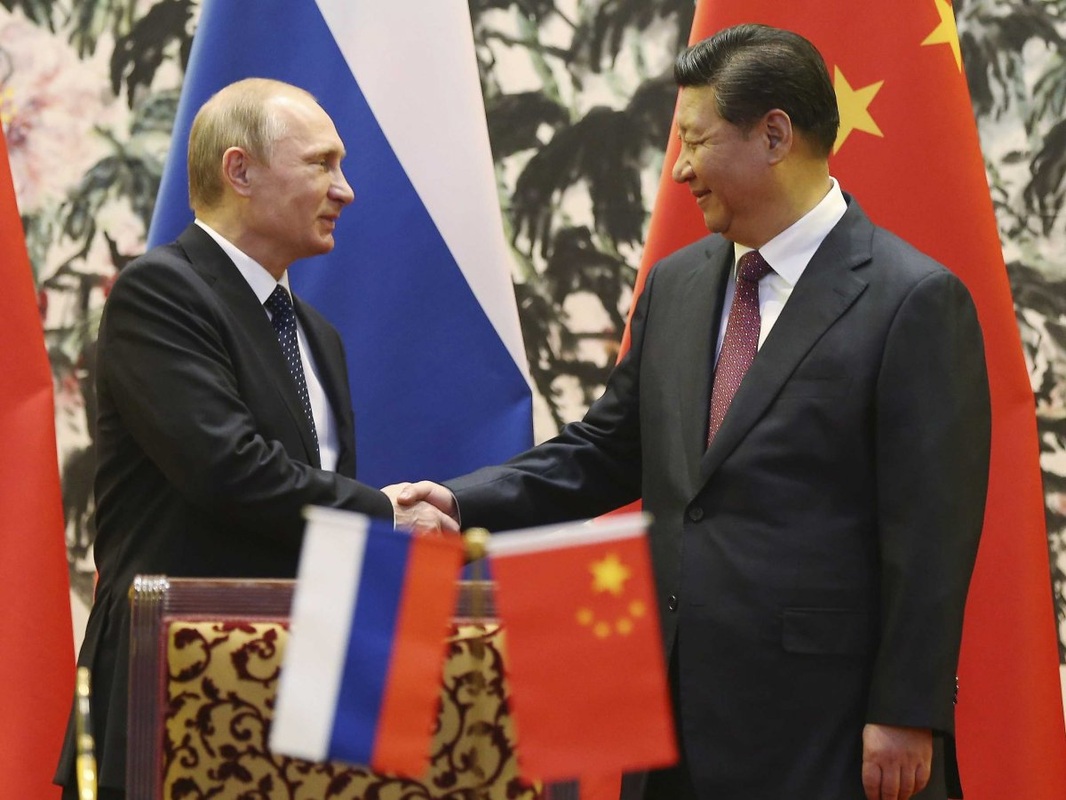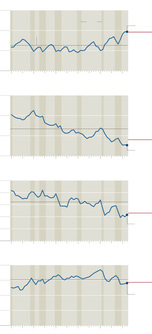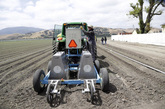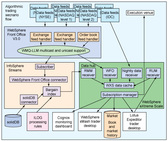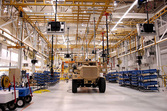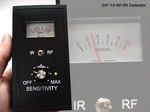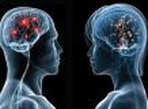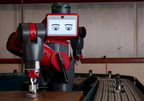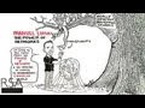Biological Teleportation: A team of Chinese scientists isolated the [H7N9 flu] virus, sequenced it, and posted in on the internet ... we downloaded it and ... synthesized the H7N9 virus"Hotel Staffed by Robots Opening in JapanA hotel with robot staff and face recognition instead of room keys will open this summer at Huis Ten Bosch theme park in Nagasaki Prefecture, Japan.
Robots will provide a wide range of services at the hotel, including room cleaning, front desk and porter services, meaning you could be checked in by robots and have robots carry your bags your room! The hotel’s first building complex is scheduled to open on 17 July 2015 with 72 rooms, followed by another 72-room building in 2016. A single room will be priced at around £40 (¥7,000) per night and a twin room will cost around £50 (¥9,000). Initially the hotel will have 10 robot members of staff, but Huis Ten Bosch company President Hideo Sawada told a news conference. “In the future, we’d like to have more than 90 percent of hotel services operated by robots.” The hotel's name, Henn-na Hotel, reflects how the hotel will “change with cutting-edge technology,” a company official said. This is a play on words: “Henn” is also part of the Japanese word for change. Huis Ten Bosch is a theme park in Nagasaki, Japan, which recreates a Dutch town, complete with actual-sized copies of old Dutch buildings to bring the experience of The Netherlands to Japan. A Direct Brain-to-Brain Interface in HumansWith the new funding, the research team will expand the types of information that can be transferred from brain to brain, including more complex visual and psychological phenomena such as concepts, thoughts and rules.
They’re also exploring how to influence brain waves that correspond with alertness or sleepiness. Eventually, for example, the brain of a sleepy airplane pilot dozing off at the controls could stimulate the copilot’s brain to become more alert. The project could also eventually lead to “brain tutoring,” in which knowledge is transferred directly from the brain of a teacher to a student. “Imagine someone who’s a brilliant scientist but not a brilliant teacher. Complex knowledge is hard to explain – we’re limited by language,” said co-author Chantel Prat, a faculty member at the Institute for Learning & Brain Sciences and a UW assistant professor of psychology. Virtual telepathy will Dominate personal communications in 2040According to "Future Timeline" by 2040, the technology is largely perfected for everyday use. It works well and is cheap enough to have spread to even developing countries. Privacy and security issues have been resolved, with personal firewalls able to restrict any unwanted intrusion or hacking attempts. The headsets, visors and earphones necessary for users have been miniaturised and made more comfortable. Some are even fully implantable. Whether for business or personal use, people everywhere are now enjoying a faster, more sophisticated, more private way of communicating.
This form of "virtual telepathy" – and the convergence of other network-based technologies – is radically reshaping society and culture during this time. A speculative bubble is formed on the stock markets, with investors everywhere forecasting a revolution in telecoms. This temporarily overheats the economy, resulting in a crash similar to that of the dotcom collapse of early 2000. The mindreading software that can listen to the 'voices in your head' - and could let the paralysed speak againScientists believe they have found a way to read our minds. They have created a computer program that can decode brain activity that creates the ‘voice in our head’ and put it into words. The breakthrough could give the ‘locked in’ or paralysed hope that they could one day communicate using the system. ‘If you’re reading text in a newspaper or book, you hear a voice in your own head,’ Brian Pasley told New Scientist .
‘We’re trying to decode the brain activity related to that voice to create a medical prosthesis that can allow someone who is paralysed or locked in to speak.’ An experiment involving a chip on a small drone shows how hardware modeled on the brain could provide useful intelligenceThe flight test was a challenge set by the Pentagon research agency DARPA as part of a project under which it has funded HRL, IBM, and others to work on neuromorphic chips. One motivation is the hope that neuromorphic chips might make it possible for military drones to make sense of video and sensor data for themselves, instead of always having to beam it down to earth for analysis by computers or humans.
Prototypes made under DARPA’s program—like HRL’s—have delivered promising results, but much work remains before such technology can perform useful work, says Vishal Saxena, an assistant professor working on neuromorphic chips at Boise State University. “The biggest challenge is identifying what the applications will be and developing robust algorithms,” he says. Google wants to flood your body with tiny magnets to search for diseaseGoogle's ambition to cure death is beginning to take shape in a new product from its Google X division. Andrew Conrad, the head of the company's life sciences division, today announced the details of an effort that would use nanotechnology to identify signs of disease. The project would employ tiny magnetic nanoparticles, said to be one-thousandth the width of a red blood cell, to bind themselves to various molecules and identify them as trouble spots.
Google's nanotechnology project, which would also involve a wearable magnetic device that tracks the particles, is said to be at least five years off, according to an accompanying report in the Wall Street Journal. The company is still figuring out how many nanoparticles are necessary to identify markers of disease, and scientists will have to develop coatings for the particles that will let them bind to targeted cells. One idea is to deliver the nanoparticles via a pill that you would swallow. DARPA sets Guinness world record for world’s fastest circuitDARPA’s Terahertz Monolithic Integrated Circuit is the first solid-state amplifier demonstrating gain above 1 THz (1012 GHz). This achievement, recognized by Guinness World Records, could open up new areas of research and unforeseen applications in the submillimeter-wave spectrum and bring unprecedented performance to circuits operating in more conventional bands. (Credit: DARPA)
“If you look at the frequency of your cell phone, it operates at 2 GHz,” Deal said. “We’re building an amplifier that amplifies radio signals at 1,000 GHz. That’s 500 times faster. Let’s compare that to a car going on the freeway. If we took our car on the freeway at 65 mph, and we sped it up by 500 times, we would be going 32,500 mph on that same road. The fastest a human being has ever traveled in a rocket ship is 27,000 mph. So it’s a big achievement, and it’s a different world.” World First As Message Sent From Brain To BrainA technique known as electroencephalogry recorded thoughts (File pic)
In a world first, a team of researchers has achieved brain-to-brain transmission of information between humans. The team managed to send messages from India to France - a distance of 5,000 miles - without performing invasive surgery on the test subjects. There were four participants in the study, aged between 28 and 50. One was assigned to a brain-computer interface to transmit the thought, while the three others were assigned to receive the thought. The first participant, located in India, was shown words translated into binary, and had to envision actions for each piece of information. How to see into the future By Tim HarfordBillions of dollars are spent on experts who claim they can forecast what’s around the corner, in business, finance and economics. Most of them get it wrong. Now a groundbreaking study has unlocked the secret: it IS possible to predict the future – and a new breed of ‘superforecasters’ knows how to do it
University students fit Florida boy with 3-D-printed armFor the first time ever, six-year-old Alex Pring hugged his mother with both arms.
The momentous feat for the six-year-old Florida boy born without part of his right arm was made possible after an engineering student and his colleagues built a prosthetic, largely out of a 3-D printer, according to the Orlando Sentinel. l"When he hugged me with two hands, he just didn't let go," Alyson Pring told the newspaper. Pring reached out to Albert Manero, currently pursuing a Ph.D. in mechanical engineering at the University of Central Florida, through e-NABLE, an online network devoted to creating 3-D printed prosthetic hands for those in need, the Orlando Sentinel reported. "My mother taught us that we're supposed to help change the world," Manero said. "That's why we did it." Upgrade Your Brain: Liquid Hard Drive Implants Could Increase Intellect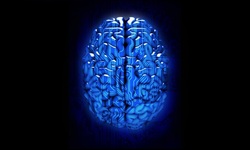
Storing photos, documents and other files in brain-implantable liquid could one day be a reality after researchers discovered a new method of storing data in microscopic particles suspended in a solution. Scientists at the University of Michigan realised that digital information could be stored on colloidal clusters after observing them switch between two states - such as the 0s and 1s of traditional bits - when placed in a liquid. Through the design and manipulation of discrete, nanoscale systems capable of encoding massive amounts of information, the basic components of computation are open to reinvention. These components will enable tagging, memory storage, and sensing in unusual environments – elementary functions crucial for soft robotics and “wet computing”. Here we show how reconfigurable clusters made of N colloidal particles bound flexibly to a central colloidal sphere have the capacity to store an amount of information that increases as O(Nln(N)). Using Brownian dynamics simulations, we predict dynamical regimes that allow for information to be written, saved, and erased. We experimentally assemble an N = 4 reconfigurable cluster from chemically synthesized colloidal building blocks, and monitor its equilibrium dynamics. We observe state switching in agreement with simulations. This cluster can store one bit of information, and represents the simplest digital colloid. Mumbai doctors bust myth, say liver grows back in 3 weeks
MUMBAI: The marvel of liver is not just its capacity for regeneration but also the swift pace at which it regenerates. A study by a Mumbai hospital has revealed that a transplanted liver in a recipient, and the remnant liver in a donor, grows back to its normal size much faster than has been previously believed. Doctors at the Kokilaben Dhirubhai Ambani Hospital (KDAH) have found that liver regeneration is nearly complete by three weeks, and does not take three months as most conventional medical textbooks suggest. The Andheri hospital that runs a living-donor transplant programme busted the myth by tracking the regeneration of liver in 11 recipients and six donors who had undergone transplants between March and November 2013. Liver is the only organ in the human body that can regrow to a near normal size from as little as 25%. In living-donor liver transplantation, a part of the donor's liver is used to replace the damaged or cancerous liver of the recipient patient. Both the remaining liver of the donor and the part transplanted into the patient grow back to full size. 
The Emotiv Insight is a wireless headset that met its $100,000 kickstarter goal on September 15th. In fact it exceeded that goal. By about $1.5 million dollars. And it seems to be a testament to our society’s readiness to use technologies that harness the power of our minds.
Multi-party quantum communication now possible, physicists demonstratePhysicists at the Institute for Quantum Computing (IQC) at the University of Waterloo have demonstrated the distribution of three entangled photons at three different locations (Alice, Bob, and Charlie) several hundreds of meters apart for the first time, proving quantum nonlocality for more than two entangled photons.
The findings of the experiment, Experimental Three-Particle Quantum Nonlocality under Strict Locality Conditions, are published in Nature Photonics. Overcoming the ‘locality loophole’ Once described by Einstein as “spooky action at a distance,” this three-photon entanglement leads to interesting possibilities for multi-party quantum communication. Nonlocality describes the ability of particles to instantaneously know about each other’s state, even when separated by large distances. In the quantum world, this means it might be possible to transfer information instantaneously — faster than the speed of light. This contravenes what Einstein called the “principle of local action,” the rule that distant objects cannot have direct influence on one another, and that an object is directly influenced only by its immediate surroundings. But what if hidden local variables are actually responsible for the correlation between the three photons; that is Einstein was right? To determine that, IQC scientists needed the experiment to close what is known as the “locality loophole.” To do that, hey had to separate the entangled photons in a way that did not allow for a signal to coordinate the behavior of the photons. So they beamed the entangled photons to trailers parked in fields several hundred meters from their lab. To ensure the locality loophole was closed, random-number generators measured the timing of the photon at each trailer independently. The time tagging devices also ensured that the measurements happened in a very small time window (three nanoseconds). Since light only travels .9 meters in that period of time, no information could possibly be transmitted from one location to the other over a distance of hundreds of meters during the measurement period — a critical condition to prove the non-locality of entanglement.* 
MIT engineers have coaxed bacterial cells to produce biofilms that can incorporate nonliving materials, such as gold nanoparticles and quantum dots.
These “living materials” combine the advantages of live cells — which respond to their environment, produce complex biological molecules, and span multiple length scales — with the benefits of nonliving materials, which add functions such as conducting electricity or emitting light. This approach could one day be used to design more complex devices such as solar cells, self-healing materials, or diagnostic sensors, says Timothy Lu, an MIT assistant professor of electrical engineering and biological engineering. Lu is the senior author of a paper describing this innovation in the March 23 issue of Nature Materials. The researchers also demonstrated that the cells can even coordinate with each other to control the composition of the biofilm. These hybrid materials could be worth exploring for use in energy applications such as batteries and solar cells, Lu says. The researchers are also interested in coating the biofilms with enzymes that catalyze the breakdown of cellulose, which could be useful for converting agricultural waste to biofuels. Other potential applications include diagnostic devices and scaffolds for tissue engineering. The research was funded by the Office of Naval Research, the Army Research Office, the National Science Foundation, the Hertz Foundation, the Department of Defense, the National Institutes of Health, and the Presidential Early Career Award for Scientists and Engineers. Whatch What You Think--Others Can

Imagine that psychologists are scanning a patient's brain, for some basic research purpose. As they do so, they stumble across a fleeting thought that their equipment is able to decode: The patient has committed a murder, or is thinking of committing one soon. What would the researchers be obliged to do with that information?
That hypothetical was floated a few weeks ago at the first meeting of the Presidential Commission for the Study of Bioethical Issues devoted to exploring societal and ethical issues raised by the government's Brain initiative (Brain Research through Advancing Innovative Neurotechnologies), which will put some $100-million in 2014 alone into the goal of mapping the brain. The commission has been asked to examine issues facing researchers and society now, as well as those around the corner. Memories Can Now Be Created — And Erased
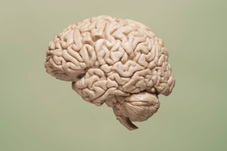
Two recently published studies describe scientists implanting fabricated memories and selectively erasing unwanted memories in the brains of lab rodents.
Researchers at UC Irvine have found that by playing a particular tone while stimulating the release of a brain chemical associated with memory formation they can artificially “condition” a response to the tone in lab rats, which is recalled and observable the following day. Fabricated memories have the same features as naturally-occurring memories, Science Daily reports, “including long-term retention.” Researchers say this represents “the first evidence that memories can be created by direct cortical manipulation.” A Mad Scientist Designing Organs That Could Give You Superpowers
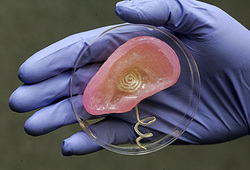
By Joseph Flaherty
Acquiring a superpower usually requires a bite from a radioactive insect, an uncomfortable dose of cosmic radiation, or the discovery of extraterrestrial parentage, but scientist Michael McAlpine hopes to make the process as simple as purchasing aspirin at the pharmacy. So far, he’s invented a “tattoo” for teeth that can detect cavities—not exactly the stuff of Hollywood blockbusters—although his latest project, a 3-D printed bionic ear that enables superhuman hearing, could be. McAlpine earned his Ph.D. in chemistry at Harvard and now is an assistant professor of mechanical and aerospace engineering at Princeton, where he leads a nine-person research group. “I was corrupted to being more of an engineer than a scientist,” says McAlpine. “I like to do stuff that’s a little more applied.” His first papers in 2003 focused on putting silicon nanowires on flexible substrates. It was an astonishing technical achievement for his time, but unfortunately it came at a point when iPods could only be controlled through a click wheel and Mark Zuckerberg was getting ready for his senior prom. Despite its scientific importance, the market wasn’t ready and McAlpine started looking for other research topics, when he asked, “Instead of trying to put nanowires on plastic substrates, why not put them on the body?” Bioengineers researching smart cameras and sensors that mimic, exceed human capability

by Catherine Hockmuth
University of California, San Diego bioengineering professor Gert Cauwenberghs has been selected by the National Science Foundation to take part in a five-year, multi-institutional, $10 million research project to develop a computer vision system that will approach or exceed the capabilities and efficiencies of human vision. The Visual Cortex on Silicon project, funded through NSF's Expeditions in Computing program, aims to create computers that not only record images but also understand visual content and situational context in the way humans do, at up to a thousand times the efficiency of current technologies, according to an NSF announcement. The Emerging Age of Technological Telepathy
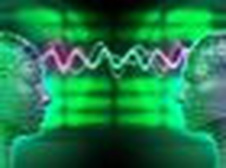
It might seem premature, but I believe the age of technological telepathy is upon us, and it won’t be long until our thoughts alone begin to manipulate the world around us.
We’ll be using intracranial implants, nanobots, functional magnetic resonance imaging (fMRI), or Electroencephalography (EEG) headbands; and our computers, our prosthetics, our avatars will all be controlled by thought alone. Biological telepathy and the somewhat related telekinesis, are recurring themes in science fiction and fantasy fiction, with perhaps the Force of the Star Wars films being one of the most well known. However, the existence of biological telepathy has not received widespread acceptance, cold reading is understood, if limited in use, and the field of parapsychology is heavily criticised for being pseudoscientific. Technological telepathy is not predictive behaviour, as we see in robots that interact with human co-workers without harm. Nor is technological telepathy the emerging science of implanting electrodes alongside the nerves and muscles of amputees, even though these technologies are quite impressive in their own right. Telepathy using technology goes much further, for example DARPA’s threat warning system that uses an EEG cap in concert with the subconscious mind’s ability to detect threats. One could argue that EEG headbands for playing games are also part of the emerging field. We see fMRI coming into use to read the mind, where it has been successfully used to communicate with some non-responsive patients. Similarly, fMRI is being used for lie detection in court. Mind reading is here now, and we can imagine its use won’t be restricted as it becomes affordable or as benefits outweigh costs. Marketers, airport security, recruiters, retirement homes, and many more industries might find fMRI and EEG mind reading quite compelling.http://www.singularityweblog.com/technological-telepathy/ Disney has developed a device to transmit sound through the human body.
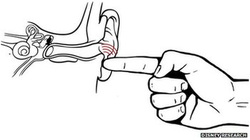
The Ishin-Den-Shin technology uses a standard microphone to record audio and then converts it into an inaudible signal transmitted through the body of the person holding the microphone.
When they touch someone's earlobe, an organic speaker is formed and the sound becomes audible, effectively whispering a message into that person's ear. The sound can be passed from person to person using any physical contact. The technology, which was developed at Disney Research in Pittsburgh, received an honorary mention at this week's Ars Electronica Festival in Linz, Austria. 5 Things You’ll Be Able to Do With Your Mind by 2050

Neuroscience and computing are advancing faster than ever. Here’s what we can look forward to.
The pill that can text from inside the body Scientists are set to trial a new ‘digital pill’ which can send a text to relatives and doctors from inside the body.

It is hoped the pills could be used to cut the number of drugs that are wasted each year as well as alert family members if medication isn’t being taken properly by elderly relatives.
Each pill contains a sensor that transmits a signal to a patch worn by the patient when the sensor itself hits the stomach acid after being swallowed. This patch then sends the data via text message or e-mail, showing that the pill has been taken. The sensor is the size of a grain of sand and is embedded into the pill alongside copper and magnesium which make an electrical circuit when they come into contact with stomach acid, much like a potato battery. This electrical circuit powers the sensor. The digital pill has been trialled as an extra dummy pill alongside normal high blood pressure medication by Lloyds Pharmacy, but there are hopes it could be used in active drugs in the future. Google has a plan. Eventually it wants to get into your brain. "When you think about something and don't really know much about it, you will automatically get information,"
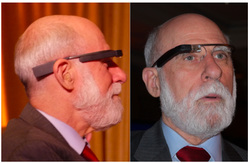
Google CEO Larry Page said in Steven Levy's book, "In the Plex: How Google Thinks, Works and Shapes Our Lives." "Eventually you'll have an implant, where if you think about a fact, it will just tell you the answer."
Google is a long way from inhabiting your brain, but the company is building wearable computers and investing heavily in artificial intelligence development to move closer to the brain. Currently, Google Glass is expensive, geeky, and forces you to look up and to the right. But it can make what your smartphone can do more hands-free. With Google Now, the company has a good idea of what comes out of your brain if you are a user of its products. It can tell you about your next appointment and how long it will take to get there, but the digital assistant can't book your family vacation. But Google has big plans for the two products, which are core to Page's long-term goal to automatically and instantly send people information as they are thinking about something. Read: A look into the mind-bending Google Glass of 2029 With his deep historical perspective, Vint Cerf, Google's chief Internet evangelist and one of the fathers of the Internet, has been exploring the possibilities of Glass. "You begin to see what can happen with a computer in the sensory environment you are in," Cerf told CNET in May. "It's the early days of this thing. By 2014, we should have a good idea of what people will want to do with Glass." Could we soon be reading people's MINDS?
|
Detecting Consciousness: A Unique Role for
|
Study finds companies older than five years destroy one million jobs a year. Younger companies create three million.PAYMEME
|
SUBMIT BOSTON MARATHON EXPLOSION TIPSSecond White Hat Bombing suspect Dzhokbar A. Tsarnaev reportedly found by police...in custody...ALIVE... robots tipped over boat...

A late-night police chase and shootout has ended with one marathon bombing suspect dead and another on the run, police here said, leaving a still-grieving city on edge. One police officer was killed and another was seriously wounded during the violent spree.
At sunrise, Gov. Deval Patrick ordered a shutdown of all public transit and residents on the edges of Boston to stay indoors as a massive manhunt for the second suspect was underway. “This is situation is grave and we are trying to protect the public safety,” said Massachusetts State Police Col. Timothy Alben, who ordered a temporary lockdown of Watertown, Waltham, Belmont, Cambridge, Newton, Allston and Brighton. FBI releases video of two 'dangerous' suspects in Boston bombing

The FBI has released video and photos of two "armed and extremely dangerous" suspects in the Boston Marathon bombing and appealed for the public's help in identifying them.
"Somebody out there knows these individuals as friends, neighbors, co-workers or family members," Boston FBI Special Agent in Charge Richard DesLauriers said at a Thursday evening briefing. FBI: 'Exercise Caution and Attempt to Verify Information Through Appropriate Official Channels Before Reporting'
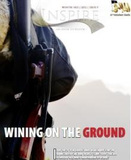
The cover of the ninth edition of Al-Qaeda in the Arabian Peninsula’s propaganda magazine, Inspire.
'Man in the White Hat' at large; Black hat man dead...
|
|
Futures Field
1 "By the year 2060, if we have not had an earthquake, we will have exceeded 85 percent of all the known intervals of earthquake recurrence in 10,000 years." - Jay Patton
See Turbidite Event History — Methods and Implications for Holocene Paleoseismicity of the Cascadia Subduction Zone, USGS: http://pubs.usgs.gov/pp/pp1661f/ Accessed 1st January 2013. 2 "Geologists say it will be nothing like the United States has ever seen." See Hurricane Sandy Will Be Dwarfed by an Earthquake, The Daily Beast: http://www.thedailybeast.com/articles/2012/11/05/hurricane-sandy-will-be-dwarfed-by-an-earthquake.html Accessed 1st January 2013. 3 "The Pacific Northwest has a long geological history of doing exactly what happened in Chile. There is an 80 percent chance the southern end of the fault off southern Oregon and Northern California could break in the next 50 years and produce a Megaquake." See Truth or Hype: Is Seattle Really at Risk for a Devastating Earthquake?, Seattle pi: http://blog.seattlepi.com/blaineweber/2010/03/23/truth-or-hype-is-seattle-really-at-risk-for-a-devastating-earthquake/ Accessed 1st January 2013 .4 Cascadia mega event, YouTube: http://www.youtube.com/watch?v=ZS80KMb89jw Accessed 1st January 2013. 5 Cascadia Tsunami, YouTube: http://www.youtube.com/watch?v=GhdcajbMVMI Accessed 1st January 2013. 6 Big Quake "Guaranteed" to Hit California by 2037, National Geographic: http://news.nationalgeographic.com/news/2008/04/080414-AP-earthquake.html Accessed 28th August 2009. 7 Epic 'Dust Bowl Of 2012' Expands Again, Climate Progress: http://thinkprogress.org/climate/2012/09/30/929381/epic-dust-bowl-of-2012-continues/ Accessed 20th October 2012. 8 UN Warns Of Food Crisis In 2013 If Extreme Weather Persists, Climate Progress: http://thinkprogress.org/climate/2012/10/16/1024581/un-warns-of-food-crisis-in-2013-if-extreme-weather-persists/ Accessed 20th October 2012. 9 Scientists Predict That Food Riots Will Grip The Planet Within A Year, Inhabitat: http://inhabitat.com/scientists-predict-that-food-riots-will-grip-the-planet-within-a-year/ Accessed 20th October 2012. 10 UN warns of looming worldwide food crisis in 2013, The Guardian: http://www.guardian.co.uk/global-development/2012/oct/14/un-global-food-crisis-warning Accessed 20th October 2012. 11 High Food Prices: 10 Questions Answered, World Food Programme: http://www.wfp.org/stories/rising-food-prices-10-questions-answered Accessed 20th October 2012. 12 "... recent food price rises are 'just the tip of the iceberg,' and consumers should brace themselves for 'massive' hikes in some commodities." See Waitrose boss: Britons should brace themselves for 'massive' food price hikes, The Telegraph: http://www.telegraph.co.uk/finance/newsbysector/retailandconsumer/9779693/ Accessed 5th January 2013. 13 See 2030. 14 When is Kate Middleton due? 5 hints at a July 2013 royal baby, Examiner: http://www.examiner.com/article/when-is-kate-middleton-due-5-hints-at-a-july-2013-royal-baby Accessed 1st January 2013. 15 China 'to overtake US on science' in two years, BBC: http://www.bbc.co.uk/news/science-environment-12885271 Accessed 14th July 2011. 16 Nasa's 2013 solar flare warning: how much do we need to worry?, The Telegraph: http://blogs.telegraph.co.uk/culture/tomchivers/100008500/nasas-2013-solar-flare-warning-how-much-do-we-need-to-worry/ Accessed 16th June 2010. 17 Gaia (spacecraft), Wikipedia: http://en.wikipedia.org/wiki/Gaia_mission Accessed 12th June 2011. 18 C/2012 S1, Wikipedia: http://en.wikipedia.org/wiki/Comet_ISON Accessed 2nd January 2012. 19 The first gene therapy in the Western world, Future Timeline Blog: http://www.futuretimeline.net/blog/2012/11/2-4.htm Accessed 2nd January 2013. 20 "The company expects 'significant volume ramp' in 2013." See Atmel's flexible touch sensors will revolutionize mobile device design, Extreme Tech: http://www.extremetech.com/electronics/125325-atmels-flexible-touch-sensors-a-revolution-in-device-design Accessed 11th April 2012. 21 See 2012. 22 PS4 and Xbox 720 – latest, Future Timeline Blog: http://www.futuretimeline.net/blog/2013/01/15.htm Accessed 20th January 2013. 23 PlayStation 4 'Orbis' pegged for 2013 release, Reg Hardware: http://www.reghardware.com/2012/03/29/sony_playstation_4_aka_orbis_pegged_for_2013_release/ Accessed 11th April 2012. 24 Orbis unmasked: what to expect from the next-gen PlayStation, EuroGamer: http://www.eurogamer.net/articles/df-hardware-orbis-unmasked-what-to-expect-from-next-gen-console Accessed 20th January 2013. 25 High-speed rail link for London, Frankfurt, CNN: http://edition.cnn.com/2010/WORLD/europe/10/19/train.london.deutsche.bahn/index.html?hpt=T2 Accessed 30th October 2010. 26 Port of Rotterdam Expansion, Science Channel: http://science.discovery.com/tv/build-bigger/projects/port-of-rotterdam/port-of-rotterdam.html Accessed 24th May 2011. 27 Intel Announces first 22nm 3D Tri-Gate Transistors, Shipping in 2H 2011, AnandTech: http://www.anandtech.com/print/4313/intel-announces-first-22nm-3d-trigate-transistors-shipping-in-2h-2011 Accessed 15th May 2011. 28 Cell Size and Scale, University of Utah (drag the slider from left to right to zoom in): http://learn.genetics.utah.edu/content/begin/cells/scale/ Accessed 15th May 2011. 29 Tiangong-2, Wikipedia: http://en.wikipedia.org/wiki/Tiangong-2 Accessed 3rd January 2013. 30 Chang'e 3, Wikipedia: http://en.wikipedia.org/wiki/Chang%27e_3 Accessed 3rd January 2013. 31 Huge Private Rocket Could Send Astronauts to the Moon or Mars, Space.com: http://www.space.com/11311-spacex-huge-private-rocket-moon-mars.html Accessed 26th April 2011. |
|

